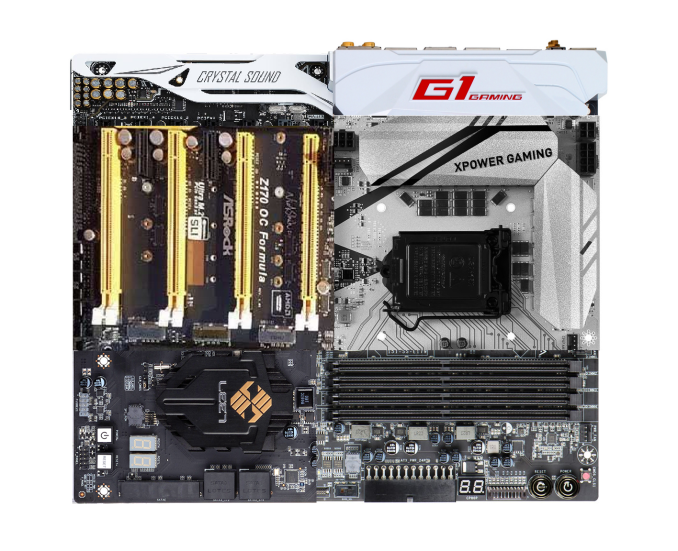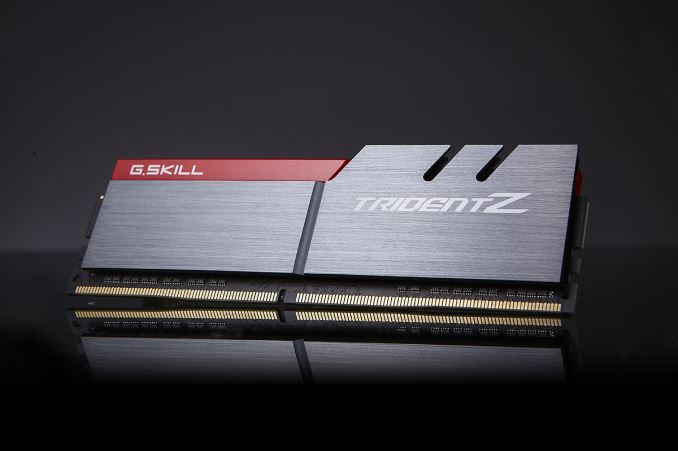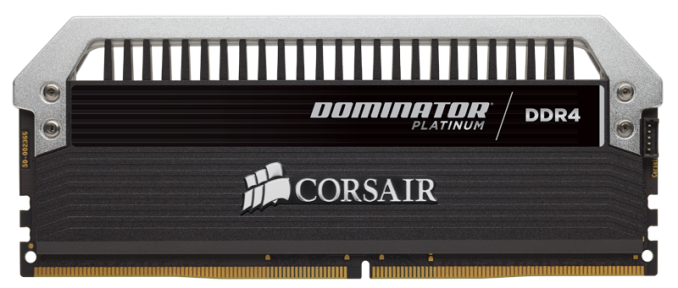The Intel 6th Gen Skylake Review: Core i7-6700K and i5-6600K Tested
by Ian Cutress on August 5, 2015 8:00 AM ESTAlso Launching Today: Z170 Motherboards, Dual Channel DDR4 Kits
The new Skylake processors are assigned a new socket – LGA1151. Intel’s policy since 2006 has been to maintain sockets for two generations and as a result moving from Broadwell to Skylake we were expecting the change. This means that Skylake processors will not work in LGA1150 based motherboards, i.e. those with Intel’s 8th and 9th generation chipsets. For Skylake we get the 100-series chipsets with additional functionality. Launching today in turn is the first member of the 100-series family, the overclocking-friendly Z170, with the other chipsets in the family to follow later in the year.
We have a large piece on the motherboards being released or talked about for Skylake, covering some 55+ products and the different variations within. The major motherboard manufacturers such as ASUS, GIGABYTE, ASRock, MSI, EVGA and a couple of others should all have a wide range ready to purchase on day one, although some models may be region specific.

The badly MSPaint’ed hybrid: MSI’s XPower Gaming Socket, GIGABYTE’s G1 Gaming IO panel, EVGA’s DRAM slots, ECS’s chipset, ASRock’s PCIe arrangement and ASUS’ Deluxe audio.
Here’s an amalgamation of some of the designs coming to end users, with almost all of them investing heavily in gaming brands with specific components to aid the user experience while gaming. Aesthetic designs are also going to be a focus of this generation, with some of the manufacturers moving into a different direction with their designs and trying some new color schemes. Some basic looking models will also be available.
Prices for Z170 motherboards will range from $80 all the way past $400+, depending on feature set and size. A number of motherboards above $150 will feature a couple USB 3.1 Gen 2 (10Gbps) ports, although you will have to check whether they are Type-A or Type-C. That being said, most motherboards with USB 3.1 will use both, but there are a select few that are C-only or A-only. Also over $150 we will see a lot of Intel’s new network controller, the I219-V, although the gaming lines might invest in Rivet Network’s Killer solution instead.
Intel is launching the Alpine Ridge controller at this time as well, which is said to support USB 3.1 Gen 2, Thunderbolt 3, HDMI 2.0, DisplayPort, and DockPort. According to our sources it would seem that GIGABYTE currently has an exclusive on this technology, and it will be used for their USB 3.1 Gen 2 ports on most motherboard models. Other functionality from the Alpine Ridge controller (TB3, HDMI 2.0) will be on a case-by-case basis depending on how the controller works in two different modes or if extra components are used. We are told that Alpine Ridge costs similarly to the ASMedia ASM1142 controller, but will enable two USB 3.1 Gen 2 ports at 10 Gbps simultaneously as it uses four PCIe lanes from the chipset.
We will go more into the 100-series chipset in the next page, but it is worth mentioning briefly here that the speed between the CPU and the chipset has increased from DMI 2.0 (5 GT/s, 2GB/sec) to DMI 3.0 (8 GT/s, 3.93GB/sec), and that the chipset has a new high speed hub (HSIO) that allows 26 lanes to be used from it although some lanes are limited (e.g. 20 PCIe 3.0 lanes maximum split into five x4 controllers). Intel’s Rapid Storage Technology is upgraded as well to give three PCIe drives access to its features as long as they are on the correct HSIO ports.
DRAM: The March to DDR4
In the world of DRAM for personal computers, DDR3 is currently king. Having been the main standard since 2007, you would be hard pressed to find a mainstream or low end platform sold that did not require access to DDR3. That changed in the enthusiast segment last year with the launch of Haswell-E which also introduced DDR4 at a high premium. For Haswell-E there was no crossover – you had no choice but to use DDR4 (unless you might be a million-unit customer).
Because the consumers and consumer product OEMs are more price sensitive, DDR4 will be a slower transition. There is precedent here in that the move from DDR2 to DDR3 saw a generation of processors that supported both standards and it was up to the motherboard manufacturer to design for it. In this transition, Skylake processors will support both DDR3L and DDR4 modules, with a few caveats.
Caveat number one is that initially, only DDR4 motherboards will be on the market. So if you upgrade now, DDR4 needs to be on the shopping list as well. We have had word of some DDR3L-only motherboards coming, as well as combo boards with DDR3L and DDR4 slots on board. Caveat one-point-five, you can use either DDR3L or DDR4, but not both at the same time.
Caveat number two, DDR3L is different to DDR3 as it operates at a lower voltage. This means that the memory controllers on Skylake most likely have a combined voltage domain, and regular DDR3 might not work (in fact early testing suggests not without reducing the voltage). Very few people currently own DDR3L DIMMs, so the likelihood of a user performing an upgrade while reusing their RAM might be slim.
Caveat number three: prices of DDR4 have dropped significantly since last year, and there is only a small premium over DDR3. The benefits of DDR4 include a lower operating voltage, a more stable design, and the ability to purchase 16GB modules with ease. That means that a Skylake platform will happily take 64GB of memory.
With that last point, we should point out that Skylake is a dual memory channel architecture, supporting two memory modules per channel. This gives a maximum of four DDR4 tests, and 4x16 = 64GB maximum.
We have been told that Skylake’s memory controller, compared to previous generations, is absolutely golden at higher speed memory support. By default Skylake supports the JEDEC standard for DDR4, 2133 MT/s at a latency of 15-15-15, but the overclocking guides we have received suggests that all processors should be able to reach DDR4-3200 relatively comfortably, with a few processors in the right motherboards going for DDR4-4000. While this should bode well for integrated graphics users, those high end kits are typically very expensive.
We currently have dual channel kits in to test from a number of the DRAM companies, and plan on performing a memory scaling article within the next few weeks to see how exactly performance might scale on Skylake. Though in the meantime, as part of this review, we were able to source a closed beta variant of a combination DDR3L/DDR4 motherboard for Skylake and have included a test comparing the two.












477 Comments
View All Comments
boeush - Friday, August 7, 2015 - link
A good point, but I think you missed this page in the review:http://www.anandtech.com/show/9483/intel-skylake-r...
The other pages where all CPUs are normalized to 3 Ghz are for generational IPC comparison, not memory scaling. The later "what you can buy" pages repeat all the same tests but with all CPUs at full default clocks, as well - to gauge the combined effect of IPC and frequency scaling across generations.
Still missing and hopefully to be addressed in a future follow-up, is a study of generational overclocked performance, and performance under DDR4 frequency scaling with and without CPU (other than memory) overclocking.
MrSpadge - Friday, August 7, 2015 - link
Well, on the page before the one you linked Ian says:"For these tests, both sets of numbers were run at 3.0 GHz with hyperthreading disabled. Memory speeds were DDR4-2133 C15 and DDR3-1866 C9 respectively."
I think this applies to both memory scaling pages.
You've got a good point, though, that the "what you can buy" section compares DDR4-2133 and DDR3-1600 (latency unspecified) at default CPU clocks. And from a quick glance the differences there are not that different from the ones obtained in the dedicated memory scaling section.
Nutti - Friday, August 7, 2015 - link
Left out all the AMD FX processors? Looks pretty bad for AMD this way. FX is still much better than 7870K. Zen will nicely catch up with Intel. AMD needs 40% improvement over FX8350 and they will sure get that through better IPC and multithreading.Bambooz - Friday, August 7, 2015 - link
Wishful thinking from a fanboiOxford Guy - Friday, August 7, 2015 - link
Ad hominem isn't a rebuttal, bud.Oxford Guy - Friday, August 7, 2015 - link
The FX does nicely in a modern game like Witcher 3 that uses all of its threads as can be seen here: http://www.techspot.com/review/1006-the-witcher-3-...Anandtech has been doing the "let's throw in a dozen APUs and completely ignore FX" for some time now. The only thing it accomplishes is obscuring the fact that the FX can be a better value for a workstation (rendering and such) that also has some gaming requirements.
nils_ - Friday, August 7, 2015 - link
You probably should have run the Linux Tests through Phoronix Test Suite, the Linux Bench seems rather outdated with Ubuntu 11.04 (we are on 15.04 now).eeessttaa - Friday, August 7, 2015 - link
Great article as always. I wish intel would leave the fivr in it. i know how hot it got but instead of removing it they should've improved on its design.Nelviego - Friday, August 7, 2015 - link
Seems it might finally be time to OC my i7 2600k and give it another 4 1/2 years. ;)Oxford Guy - Friday, August 7, 2015 - link
Intel made everyone think Skylake was going to be a massive improvement on all fronts. Massive IPC increase. Massive technological advance. People shilled for Intel by claiming it was highly likely that Skylake wouldn't need a new socket and would just use LGA 2011-3.Instead, we get ... what? Chips that aren't significantly better than Haswells, let alone Broadwell?
I guess Intel is sandbagging even more than usual since AMD isn't doing anything new on the CPU front. So much for all of the intense Skylake hype. It amazes me, too, how people are blithely now saying "I guess I'll wait for Kaby Lake" -- the same people, often enough, who said Skylake would revolutionize computing.
It looks like this is what happens when Intel has minimal competition. The FX chips are still clinging to relevance now that consoles have 8 threads and weak individual cores (not that you'd know it based on the way this site never puts even one of them into its reviews in favor of weaker APUs) -- and because rendering programs like Blender can use their threads which can make them a decent value for budget workstation use, but their design is from 2012 or so. Overclocking is also keeping old chips like the 2500K viable for gaming.
I admit I feel for the hype a bit. I was expecting at least some sort of paradigm-shifting new tech. Instead... I don't see anything impressive at all. A new socket... a small gain in efficiency... rinse repeat.
An article I read recently said that overclocking will become increasingly non-viable as process nodes shrink. It seems we're seeing that already. The article says an Intel executive said Intel is taking overclocking seriously but the company may not have much choice.
Intel should have included hardware devoted to h.265 encoding for Skylake at least. Maybe it did, but it's not like I can tell by the charts provided. What is the point of putting in that h.265 encoding chart and not including the fastest non-E Haswell (4790K) and a Haswell-E (5820K)? It makes it look like your site is trying to hype Skylake. Don't you think people who are doing a lot of tasks like that which require serious performance (like the "slowest" setting in Handbrake) are going to need to see a comparison with the best available options?